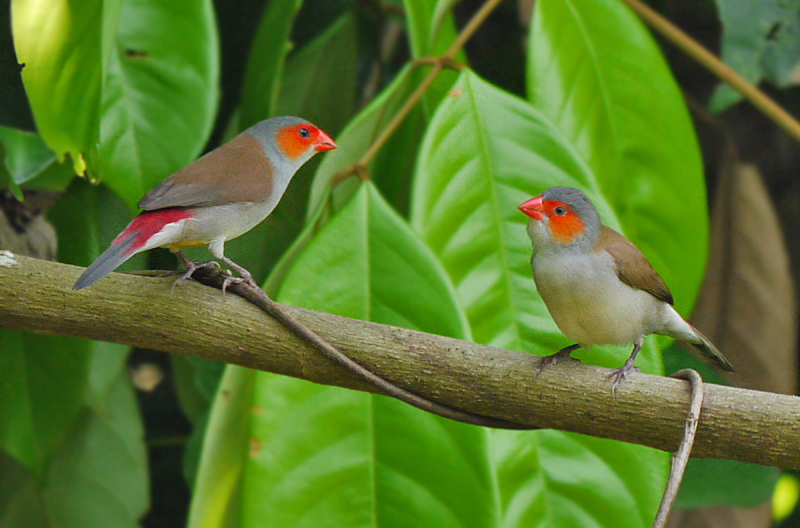Orange-cheeked waxbills are found in the grasslands of the western parts of the African continent, where they live in flocks of up to 30 birds. They’re rare in Australian aviculture, held only in the aviaries of specialist breeders. You would expect to pay around $1,000 Australian dollars for a pair.

Diet & Feeding
A quality finch seed mix including canary seed and various millets forms the basis of the orange-cheeked waxbill’s diet. Sprouting seed increases its nutritional value and is an effective way to improve your bird’s health and breeding performance. Freshly grown green seed heads should also be offered frequently.
Some leafy greens should be provided throughout the year. Kale, bok choy, endive, and silverbeet are the most nutritious and will be readily eaten. Spinach can also be given, but only sparingly as it can contribute to calcium deficiency.
Live food is an important component of the orange-cheeked waxbill’s diet and should be provided throughout the year—especially during the breeding season. Mealworms, maggots, termites, and small crickets will be consumed readily. Commercial soft finch food mixes can also be provided for an added nutrient boost, which is especially useful when breeding.
Housing & Compatibility
Orange-cheeked waxbills are peaceful birds that do well in a mixed finch collection of other placid finches, as either a single pair or a small colony. Due to their rarity in Australian aviaries it’s recommended to house them as single pairs in long planted flight aviaries.
They should not be mixed with finches in the African waxbill group, as hybridization will occur. These include the cordon bleu finches, St Helena waxbill, purple grenadier waxbill, and the violet-eared waxbill.
During the breeding season, orange-cheeked waxbills—particularly the males—will fiercely protect their nesting area. It may be necessary to remove any previous clutches of orange-cheeked waxbills to reduce the risk of aggression.
The aviary should be protected from wind and cold, as orange-cheeked waxbills do not tolerate low temperatures very well.
Breeding Orange-Cheeked Waxbills
Best breeding results are achieved in spring through to early autumn, with a hen bird that’s at least 12 months old. Better breeding results are usually achieved in the second year of breeding. These birds demand privacy to breed successfully and will not tolerate nest inspections.
Orange-cheeked waxbills prefer to nest in dense brush, but will accept artificial nesting boxes. They will construct a nest from fine strands of dry grass and line it with feathers. Multi-chamber nests are sometimes built, with a smaller “fake” nest constructed on top of the actual nest. The nest will often be re-used for subsequent clutches.
They typically lay 3-6 eggs in each clutch, which are incubated by both parents for approximately two weeks. Young birds fledge the nest at three weeks of age and are usually independent after a further month. Adult plumage is attained at three months of age.
Young birds be can left with their parents when they reach independence, however due to their rarity it’s best to separate them to completely eliminate the risk of parental aggression.
Sexing
Difficult to visually sex, so DNA sexing may be required. Only male orange-cheeked waxbills will sing (to court the females), so observational sexing is possible. Males also have a slightly darker patch of orange near their vent.
Mutations
There are no established mutations in Australia.
Health & Lifespan
The orange-cheeked waxbill’s diet is high in live food, making them especially vulnerable to parasitic infection. A strict worming and parasite control regime should be implemented to ensure their long-term health. We recommend Moxidectin Plus.
Healthy birds can be expected to reach approximately 7-8 years of age.